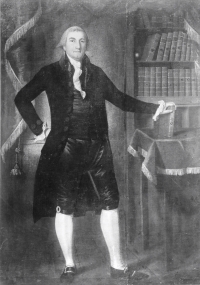
When Pierre L’Enfant produced his design for the new federal city in 1791, his plan did not include burial grounds. With the relocation of the nation’s capital from Philadelphia to the District of Columbia set to happen by 1800, DC’s commissioners anticipated the influx of population that would follow and set aside land in 1798 for two cemeteries on the outskirts of the city, one on the west side and the other on the east. When the site on the east side of the city proved to be unsuitable for burials, a group of parishioners of Christ Church on Capitol Hill established a new burial ground along the Anacostia River, two miles from the Capitol. In time this cemetery came to be regarded as the first national burial ground, known by the 1830s as Congressional Cemetery.1
Just a few months after the Christ Church cemetery opened, Senator Uriah Tracy of Connecticut became the first member of Congress to be buried there. A Revolutionary War veteran and former president pro tempore of the Senate, Tracy died on July 19, 1807, and a few days later was interred in the cemetery “with the honors due to his station and character, as a statesman.” A member of the House of Representatives was buried there in 1808, and the following year Senator Francis Malbone of Rhode Island, who died on the steps of the Capitol after only three months in office, was interred there as well. Vice President George Clinton was interred there in 1812 and Vice President Elbridge Gerry followed in 1814, each escorted to his final resting place by a grand procession down Pennsylvania Avenue.2
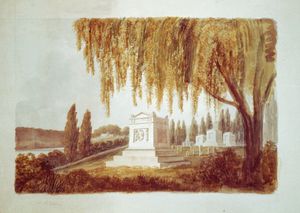
The Washington Parish Burial Ground, founded by private investors in 1807 and deeded to Christ Church in 1812, was a public cemetery. It reserved a portion of its plots for indigents who could not afford burial, but its regulations barred “infidels” and African Americans from burial within the walled section of the cemetery. (The first African Americans would not be buried at the cemetery until 1829, and only then in a segregated area outside the original enclosed portion.) In addition to serving as the final resting place for some members of Congress, the cemetery also accommodated Senate officers, staff members, and even laborers who worked at the Capitol. William Swinton, a stonecutter who had worked on construction of the Capitol, was the first individual interred there in April 1807, just days after the cemetery was created. The Senate’s first doorkeeper and sergeant at arms, James Mathers, was laid to rest in the cemetery in 1811, as was the first secretary of the Senate, Samuel Otis, in 1814. Numerous members of the Tims family, who worked as doorkeepers, messengers, and pages in the early Senate, also found their final resting place in the cemetery.
During the early years of the 19th century, embalming practices did not allow for long-distance transportation of the deceased, making local burial a necessity. Consequently, when a member of Congress died during a congressional session, he was typically buried in a local cemetery. Between 1807 and 1830, the majority of members of Congress who died in the District of Columbia were buried at this site. Facing this reality, in 1817 Christ Church donated 100 burial sites for the interment of representatives and senators. In 1820 it opened those sites to the families of members of Congress as well as the heads of cabinet departments. A few years later, the church provided 300 additional burial sites for members of Congress and government officials. Around this time, the site became popularly known as Congressional Cemetery.3
To give distinction to the gravesites of lawmakers, Congress in 1815 commissioned Capitol architect Benjamin Latrobe to design a stately monument to honor each of the deceased members. Latrobe’s design featured a large cube topped with a small, conical dome made from the same sandstone used to construct the Capitol. An engraved marble plaque identified the deceased. Latrobe believed the monuments would be more durable than the typical marble headstones in use at the time.
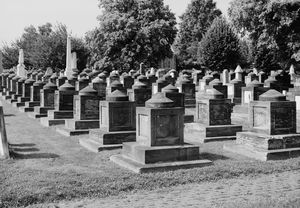
As years went by, improvements in embalming practices and in transportation—particularly with the construction of railroads—made it possible to return the deceased to home-state cemeteries. It became more common for members to be temporarily interred at the cemetery, then later transported for a home-state burial, leaving the space beneath the monument empty. For decades to come, Congress continued to add a monument to the cemetery whenever a member died in office, regardless of whether or not mortal remains ever rested there. By the 1870s, the cemetery held more than 150 of the Latrobe-designed monuments, arranged in long rows, although only about half actually covered a body. They became known as “cenotaphs,” which means “empty tomb.”4
Unfortunately, the stone markers weathered poorly over time and became increasingly unpopular with Washingtonians, including some members of Congress. One representative complained that the cenotaphs resembled a huge “dry-goods box with an old-fashioned bee-hive on top . . . , the most complete consummation of hideousness that it has ever been my misfortune to observe in a cemetery.” Above all, prayed another, “I hope to be delivered from dying—[at least] while Congress is in session.” When a bill was introduced in 1876 to require production of a granite monument matching the existing cenotaphs for future representatives and senators interred at the cemetery, Representative (and later Senator) George Hoar succeeded in striking the requirement from the bill. “It is certainly adding new terror to death,” Hoar stated, to require deceased members to lie beneath a cenotaph. This marked the end of new cenotaphs in Congressional Cemetery for nearly a century. A number of members of Congress were interred there in the years following, but those graves were marked with small headstones. One last cenotaph was placed in 1972 to mark the passing of House Majority Leader Hale Boggs who perished in a plane crash that year, his body never recovered.5
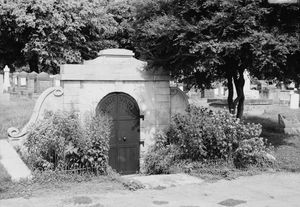
Though Congress did not have a formal relationship with Christ Church or ownership of the cemetery, it played an important financial role in the burial ground’s care and maintenance. Following the first congressional burials in the early 19th century, Christ Church officials hoped the donation of burial plots to Congress would strengthen ties with lawmakers and lead to financial support for the cemetery as a quasi-public institution. In 1824 Congress appropriated $2,000 to Christ Church to build a wall around the cemetery. Congress contributed more funds in the 1830s to build a house for the cemetery caretaker, plant trees, and “otherwise improve the interment of members of Congress and other officers of the General Government.” Between 1832 and 1834, Congress also appropriated $2,800 to build a vault to hold bodies awaiting burial, a service provided to representatives and senators free of charge. (Former First Lady Dolley Madison was interred there for three years while funds were raised to allow her to be moved for burial at her husband’s Montpelier estate in Virginia.) By 1846 Congress had appropriated $10,000 for upkeep and repairs. That year, when Congress provided funds for the cemetery and the road that led to from the Capitol, it used the name “Congressional Burial Ground,” solidifying its special relationship to the cemetery.6
With the establishment of Arlington Cemetery after the Civil War, Congressional Cemetery yielded its active role as the chief national burial ground. By that time, the cemetery had been the site for grand funeral services for deceased presidents William Henry Harrison, Zachary Taylor, and John Quincy Adams, and the final resting place of U.S. Attorney General William Wirt and U.S. Secretary of State John Forsythe. During the late 19th century, notable individuals from Senate and House history continued to be interred there, including former sergeant at arms Dunning McNair; Isaac Bassett, one of the first Senate pages and later a longtime doorkeeper of the Senate; Joseph Gales and William Seaton, early newspapermen who recorded congressional debates; and Anne Royall, one of the first women journalists to cover Congress. The cemetery also continued to serve private citizens well into the 20th century, eventually providing the resting place for 60,000 individuals, including pioneering photographer Matthew Brady, famed military composer and conductor John Philip Sousa, and FBI Director J. Edgar Hoover, a Washington native.
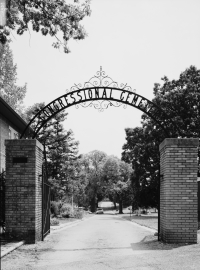
By the mid-20th century, Congress had long ceased providing appropriations for the cemetery, and Christ Church’s congregation lacked the resources to maintain it. Despite efforts by groups such as the Daughters of the American Revolution to generate public and congressional support for the historic site, it gradually fell into disrepair. In 1976 a nonprofit organization, the Association for the Preservation of Historic Congressional Cemetery (APHCC), assumed management of the site. After decades of neglect, however, the APHCC struggled to keep up with the overgrown grass and weeds, repair broken monuments and crumbling private vaults, and protect the grounds from vandalism. That year Congress passed legislation authorizing the architect of the Capitol to assist in the maintenance of the cemetery and appropriated funds for that purpose. Congress did not provide additional funds in the years following, however, and by 1997 Congressional Cemetery had fallen on such hard times that the National Trust for Historic Preservation added it to its list of most endangered historic sites. Neighborhood volunteers—especially dog owners who frequented the grounds with their pets and formed the K9Corps at Historic Congressional Cemetery—worked with the APHCC to raise money and devoted hundreds of hours to bringing the cemetery back to life. In 1997 volunteers from all five branches of the military gathered at the site to mow the grass and repair headstones, an event that continues to be an annual tradition. As the cemetery’s 200th anniversary approached, Congress once again provided monetary support, passing legislation in 1999 and 2002 to establish an endowment for its ongoing restoration and maintenance. The cemetery was designated a National Historic Landmark in 2011.7
Through the efforts of local volunteers and with funds appropriated by Congress, Congressional Cemetery, the first national burial ground, has been restored as both a meaningful community space and a monument to the elected officials who died while serving their nation in Washington, DC. At least 80 members of Congress are interred at Congressional Cemetery alongside the cenotaphs that memorialize the passing of dozens more.
Notes
7. Johnson and Johnson, In the Shadow of the United States Capitol, 223–64; “Ruin of Tombs,” Milwaukee Sentinel, August 31, 1890, 9; House of Representatives, Committee on Interior Affairs, “Relating to the Preservation of the Historical Congressional Cemetery,” H. Rpt. 667, 97th Cong., 2nd sess., July 27, 1982; Betsy Crosby, “To Hell and Back: The Resurrection of Congressional Cemetery,” Preservation (January/February 2012): 28–33; “The Cemetery Lost Its Aura,” Washington Star, September 19, 1971, 1; “New Panel Eyes Cemetery Bill,” Washington Post, July 28, 1976, A15; “A Gentle Reminder of Congressional History, 20 Blocks from Capitol Hill,” Roll Call, September 18, 1988, 31; “Congressional Cemetery Could Get Funding,” Roll Call, July 26, 2001, 46.